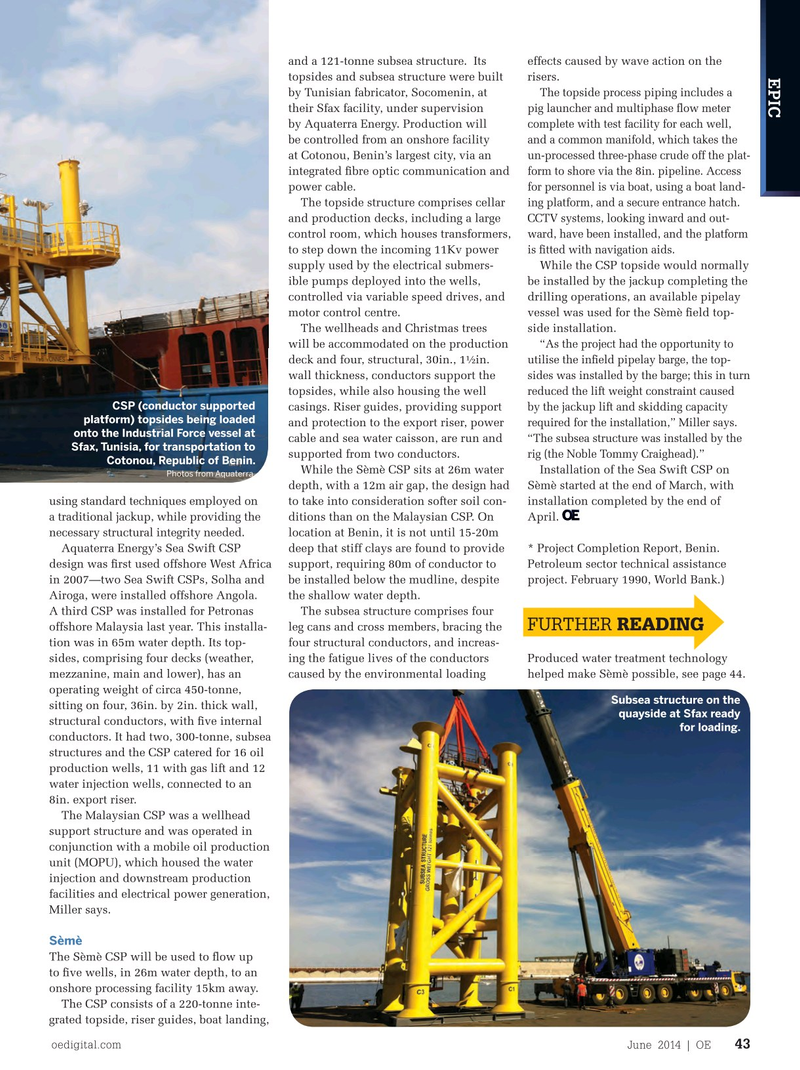
Page 41: of Offshore Engineer Magazine (Jun/Jul 2014)
Read this page in Pdf, Flash or Html5 edition of Jun/Jul 2014 Offshore Engineer Magazine
and a 121-tonne subsea structure. Its effects caused by wave action on the
EPIC topsides and subsea structure were built risers.
The topside process piping includes a by Tunisian fabricator, Socomenin, at pig launcher and multiphase ? ow meter their Sfax facility, under supervision complete with test facility for each well, by Aquaterra Energy. Production will and a common manifold, which takes the be controlled from an onshore facility un-processed three-phase crude off the plat- at Cotonou, Benin’s largest city, via an form to shore via the 8in. pipeline. Access integrated ? bre optic communication and for personnel is via boat, using a boat land- power cable. ing platform, and a secure entrance hatch.
The topside structure comprises cellar
CCTV systems, looking inward and out- and production decks, including a large ward, have been installed, and the platform control room, which houses transformers, is ? tted with navigation aids.
to step down the incoming 11Kv power supply used by the electrical submers- While the CSP topside would normally ible pumps deployed into the wells, be installed by the jackup completing the controlled via variable speed drives, and drilling operations, an available pipelay motor control centre. vessel was used for the Sèmè ? eld top-
The wellheads and Christmas trees side installation. “As the project had the opportunity to will be accommodated on the production utilise the in? eld pipelay barge, the top- deck and four, structural, 30in., 1½in. sides was installed by the barge; this in turn wall thickness, conductors support the reduced the lift weight constraint caused topsides, while also housing the well CSP (conductor supported by the jackup lift and skidding capacity casings. Riser guides, providing support platform) topsides being loaded required for the installation,” Miller says. and protection to the export riser, power onto the Industrial Force vessel at “The subsea structure was installed by the cable and sea water caisson, are run and
Sfax, Tunisia, for transportation to rig (the Noble Tommy Craighead).” supported from two conductors.
Cotonou, Republic of Benin.
While the Sèmè CSP sits at 26m water Installation of the Sea Swift CSP on
Photos from Aquaterra.
depth, with a 12m air gap, the design had Sèmè started at the end of March, with using standard techniques employed on to take into consideration softer soil con- installation completed by the end of a traditional jackup, while providing the ditions than on the Malaysian CSP. On April. necessary structural integrity needed. location at Benin, it is not until 15-20m
Aquaterra Energy’s Sea Swift CSP deep that stiff clays are found to provide * Project Completion Report, Benin. design was ? rst used offshore West Africa support, requiring 80m of conductor to Petroleum sector technical assistance in 2007—two Sea Swift CSPs, Solha and be installed below the mudline, despite project. February 1990, World Bank.)
Airoga, were installed offshore Angola. the shallow water depth.
A third CSP was installed for Petronas The subsea structure comprises four
FURTHER READING offshore Malaysia last year. This installa- leg cans and cross members, bracing the tion was in 65m water depth. Its top- four structural conductors, and increas- sides, comprising four decks (weather, ing the fatigue lives of the conductors Produced water treatment technology mezzanine, main and lower), has an caused by the environmental loading helped make Sèmè possible, see page 44.
operating weight of circa 450-tonne,
Subsea structure on the sitting on four, 36in. by 2in. thick wall, quayside at Sfax ready structural conductors, with ? ve internal for loading.
conductors. It had two, 300-tonne, subsea structures and the CSP catered for 16 oil production wells, 11 with gas lift and 12 water injection wells, connected to an 8in. export riser.
The Malaysian CSP was a wellhead support structure and was operated in conjunction with a mobile oil production unit (MOPU), which housed the water injection and downstream production facilities and electrical power generation,
Miller says.
Sèmè
The Sèmè CSP will be used to ? ow up to ? ve wells, in 26m water depth, to an onshore processing facility 15km away.
The CSP consists of a 220-tonne inte- grated topside, riser guides, boat landing, oedigital.com June 2014 | OE 43 042_OE0614_EPIC_Aquaterra.indd 43 5/22/14 9:58 PM

 40
40

 42
42